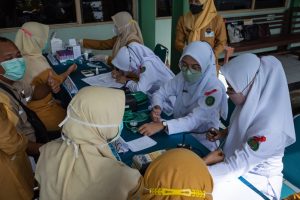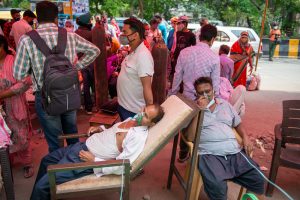Imagine discovering a hidden health issue before it becomes a major problem. Thalassemia, a genetic blood disorder, is particularly common among Singapore’s communities.
Regular screenings can catch this condition early, offering a chance to manage it effectively and prevent severe health complications.
In Singapore, about 4.5% of the population are carriers of the thalassaemia gene. By understanding the importance of these screenings, you can take proactive steps to ensure a healthier future for yourself and your loved ones.
What is Thalassemia?
Thalassemia is a genetic blood disorder that impairs the body’s ability to produce healthy haemoglobin, the vital protein in red blood cells responsible for transporting oxygen to all parts of the body. This deficiency leads to a reduction in the number of red blood cells and results in anaemia, which can cause symptoms such as fatigue, weakness, pale skin, and shortness of breath.
The disorder is inherited in an autosomal recessive manner, meaning that a child needs to inherit two defective genes (one from each parent) to develop the disease. Carriers of the thalassemia gene, also known as having the thalassemia trait, do not usually exhibit symptoms but can pass the gene to their offspring. This makes it crucial for individuals, especially those planning to have children, to be aware of their carrier status.
Regular screenings are essential as they can detect the presence of the thalassemia trait or disease early on. Early detection allows for timely medical intervention, which can prevent severe complications such as iron overload, bone deformities, and heart and liver problems.
Moreover, for couples who are both carriers, genetic counselling can provide information on the risk of having a child with severe thalassemia and discuss options to prevent this outcome.
High Carrier Frequency
Thalassemia in Singapore is notably prevalent due to its diverse multiracial population. Research shows a significant carrier frequency among the major ethnic groups. Approximately 6.4% of Chinese, 4.8% of Malays, and 5.2% of Indians carry α-thalassemia mutations.
For β-thalassemia mutations, the carrier frequencies are about 2.7% in Chinese, 6.3% in Malays, and 0.7% in Indians. This high prevalence highlights the necessity of regular screenings to identify carriers and manage the condition effectively.
Carriers of the thalassemia gene typically do not exhibit symptoms themselves but can pass the gene to their children. If both parents are carriers, there is a 25% chance with each pregnancy that their child will inherit the disease. This makes it crucial for individuals to be aware of their carrier status, particularly those planning to start a family. Regular screening programs can identify these carriers early, allowing for informed family planning decisions and timely medical interventions to manage potential health issues.
Early Detection and Prevention
Early detection of thalassemia in Singapore through regular screenings is crucial for preventing severe health complications. Screening programs, particularly for pregnant women and their partners, have proven effective in identifying at-risk couples. This allows for early intervention and informed decision-making.
For example, a study in Thailand demonstrated the success of consistent screening programs in preventing severe thalassemia cases. This approach not only proves to be cost-effective but also highlights the importance of early detection in managing genetic conditions.
In Singapore, implementing similar screening programs can provide numerous benefits. Early identification of carriers allows for timely medical advice and interventions, ensuring better health outcomes for both parents and children. Regular thalassemia screenings can thus play a vital role in mitigating the impact of the disorder.
The Thalassemia Screening Process
Thalassemia screening in Singapore involves a straightforward and non-invasive process designed to identify carriers and individuals affected by the disorder. The screening typically begins with a blood test, which is used to measure the levels of haemoglobin and other red blood cell indices. One of the key tests performed is the Mean Corpuscular Haemoglobin (MCH) test, which helps detect abnormal haemoglobin levels indicative of thalassemia. If the initial screening results suggest the possibility of thalassemia, further tests, such as haemoglobin electrophoresis or DNA analysis, may be conducted to confirm the diagnosis and identify the specific type of thalassemia.
Screening is often offered to individuals at higher risk, such as those with a family history of thalassemia or couples planning to have children. For pregnant women, antenatal screening is particularly important as it helps identify carrier status early, allowing for timely counselling and management. The entire process is relatively quick and is usually done during routine check-ups or through special screening programs in clinics and hospitals across Singapore.
Through this simple yet effective screening process, individuals can gain crucial insights into their health, enabling early intervention and better management of thalassemia. This proactive approach is essential in reducing the impact of the disorder and ensuring better health outcomes for those affected.
Economic Benefits of Regular Screenings
One of the significant advantages of regular thalassemia screenings in Singapore is their cost-effectiveness. Early detection programs are much less expensive than treating severe cases of thalassemia, which often require lifelong medical care, including regular blood transfusions and iron chelation therapy. These treatments can place a considerable financial burden on both families and the healthcare system.
Research shows that the cost of implementing screening and prevention programs is significantly lower than the ongoing expenses associated with managing severe thalassemia cases. By investing in regular screenings, Singapore can reduce the overall healthcare costs associated with this genetic disorder.
Moreover, these programs not only save money but also improve the quality of life for those affected by thalassemia. Early detection and management can help mitigate complications, leading to better health outcomes and less strain on healthcare resources.
Improved Quality of Life
Regular thalassemia screenings in Singapore not only offer economic benefits but also significantly enhance the quality of life for individuals affected by the condition. Early detection allows for timely medical interventions that can manage and prevent complications associated with thalassemia. For instance, managing iron overload, a common complication in thalassemia patients, can prevent serious health issues such as liver and heart disease.
Screenings enable healthcare providers to monitor and treat complications more effectively, ensuring that patients receive appropriate care to maintain their health. Regular monitoring and treatment can help individuals with thalassemia lead healthier and more fulfilling lives. Moreover, early intervention can reduce the severity of symptoms, allowing patients to engage in daily activities with greater ease and comfort.
For families, regular screenings provide peace of mind, knowing that potential health issues can be addressed promptly. This proactive approach not only improves individual health outcomes but also reduces the overall burden of thalassemia on families and the healthcare system. By prioritising regular thalassemia screenings, Singapore can ensure a better quality of life for those affected and foster a healthier community.
The Path Forward
Regular thalassemia screenings in Singapore are not just a medical necessity but a societal imperative. With a significant portion of the population being carriers, early detection through these screenings can profoundly impact public health. By embracing and investing in comprehensive screening programs, Singapore can prevent the severe health complications associated with thalassemia, ultimately saving lives and reducing healthcare costs.
It’s clear that the benefits of regular thalassemia screenings far outweigh the costs. These programs empower individuals with knowledge about their health, allowing for timely medical interventions and informed family planning decisions. More importantly, they foster a culture of proactive health management, where the community takes collective steps towards better health outcomes.
Singapore has the opportunity to lead by example in the fight against genetic disorders like thalassemia. By prioritising regular screenings, the nation can ensure a healthier, more resilient population. It’s time for Singaporeans to recognise the critical importance of thalassemia screenings and to advocate for widespread, accessible programs that safeguard the health of current and future generations.
References
- Thalassaemia – What is, Types of Thalassaemia | SingHealth. (n.d.). https://www.sgh.com.sg/patient-care/conditions-treatments/thalassaemia-childhood-illnesses#:~:text=In%20Singapore%2C%20about%204.5%25%20of,carriers%20of%20the%20thalassaemia%20gene.
- Yin, S. K. K., Chong, Q. T., Mei, L. A., Lin, T. P., Fraser, A., Chuan, S. C. S., & Juh, A. Y. E. (2004). A Molecular Epidemiologic Study of Thalassemia Using Newborns’ Cord Blood in a Multiracial Asian Population in Singapore: Results and Recommendations for a Population Screening Program. https://www.semanticscholar.org/paper/A-Molecular-Epidemiologic-Study-of-Thalassemia-Cord-Yin-Chong/a29dc0a6d5521f4ba55c1cd3930b70e743432ee1
- Pengpinij, C., Maneekanondh, N., Khunprama, P., & Sanchaisuriya, K. (2010). Performance of thalassemia screening program for identification of at-risk couples at Prayuen Hospital, Khon Kaen province. https://www.semanticscholar.org/paper/Performance-of-thalassemia-screening-program-for-of-Pengpinij-Maneekanondh/73a98aca602aadf950a7895c1735e3bc61cbbbb4
- Wanthong, S., Fucharoen, G., & Fucharoen, S. (2012). Screening for prevention and control of severe thalassemia at Maung Saung Hospital, Roiet province: 6 years of experience. https://www.semanticscholar.org/paper/Screening-for-prevention-and-control-of-severe-at-6-Wanthong-Fucharoen/747349e7b720af2532f676031863b1b0ec11c44d
- Lam, J. C. M., Lee, S. Y., Koh, P. L., Fong, S. Z., Abdul-Kadir, N. I., Lim, C. Y., Zhang, X., Bhattacharyya, R., Soh, S. Y., Chan, M. Y., Tan, A. M., Kuperan, P., & Ang, A. L. (2021). Clinical and health-related quality of life outcomes of transfusion-dependent thalassaemia patients in Singapore. Blood Cells, Molecules, & Diseases/Blood Cells, Molecules & Diseases, 88, 102547. https://doi.org/10.1016/j.bcmd.2021.102547
- Lee, S. Y., Yap, E., Lee, E. Y., Goh, J., Liu, T. C., & Yip, C. (2019). Evaluation of Thalassaemia Screening Tests in the Antenatal and Non-Antenatal Populations in Singapore. https://www.semanticscholar.org/paper/Evaluation-of-Thalassaemia-Screening-Tests-in-the-Lee-Yap/6ac5843ca1de8dd0e341171ef34e95cf12b58b7a














